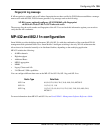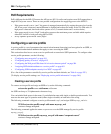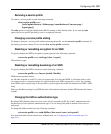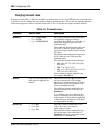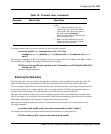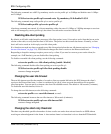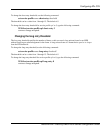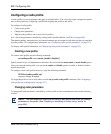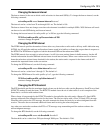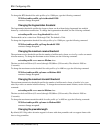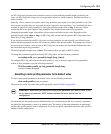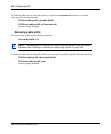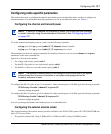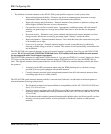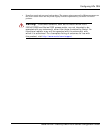
Configuring APs 313
Nortel WLAN—Security Switch 2300 Series Configuration Guide
Changing the beacon interval
The beacon interval is the rate at which a radio advertises its beaconed SSID(s). To change the beacon interval, use the
following command:
set radio-profile name beacon-interval interval
The interval can be a value from 25 ms through 8191 ms. The default is 100.
The beacon interval does not change even when advertisement is enabled for multiple SSIDs. WSS Software still sends
one beacon for each SSID during each beacon interval.
To change the beacon interval for radio profile rp1 to 200 ms, type the following command:
WSS# set radio-profile rp1 beacon-interval 200
success: change accepted.
Changing the DTIM interval
The DTIM interval specifies the number of times after every beacon that a radio sends a delivery traffic indication map
(DTIM). An AP sends the multicast and broadcast frames stored in its buffers to clients who request them in response to
the DTIM. The DTIM interval applies to both the beaconed SSID and the unbeaconed SSID.
The DTIM interval does not apply to unicast frames. An AP also stores unicast frames in buffer memory, but the AP
includes information about the buffered unicast frames in each beacon frame. When a user station receives a beacon
frame that advertises unicast frames destined for the station, the station sends a request for the frames and the AP
transmits the requested frames to the user station.
To change the DTIM interval, use the following command:
set radio-profile name dtim-interval interval
The interval can be a value from 1 through 31. The default is 1.
To change the DTIM interval for radio profile rp1 to 2, type the following command:
WSS# set radio-profile rp1 dtim-interval 2
success: change accepted.
Changing the RTS threshold
The RTS threshold specifies the maximum length a frame can be before a radio uses the Request-to-Send/Clear-to-Send
(RTS/CTS) method to send the frame. The RTS/CTS method clears the air of other traffic to avoid corruption of the
frame due to a collision with another frame.
When a frame is long enough for the RTS/CTS method to be applicable, the radio sends a Request-To-Send (RTS)
message addressed to the intended receiver for the frame. The receiver replies with a Clear-To-Send (CTS) message.
When the radio receives the CTS message, the radio transmits the frame and waits for an acknowledgment from the
receiver. The radio does not transmit additional frames until receiving the acknowledgment.
Any other user station that overhears the RTS or CTS message stops transmitting until the station overhears the
acknowledgment message.
To change the RTS threshold, use the following command:
set radio-profile name rts-threshold threshold
The threshold can be a value from 256 bytes through 3000 bytes. The default is 2346.



